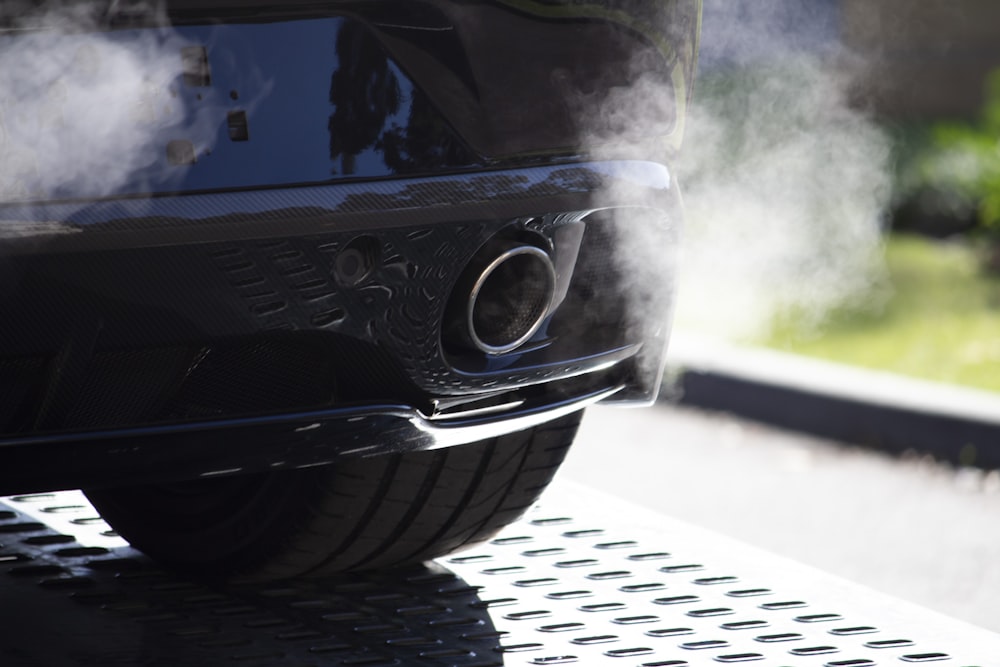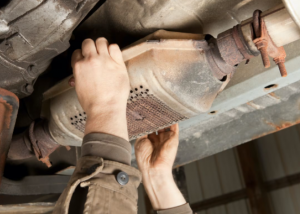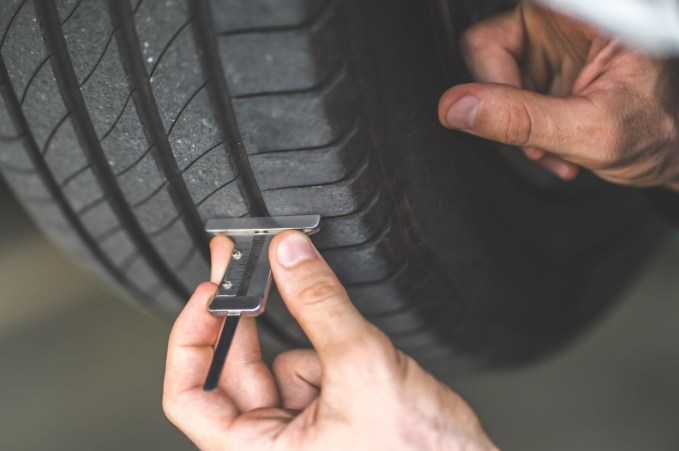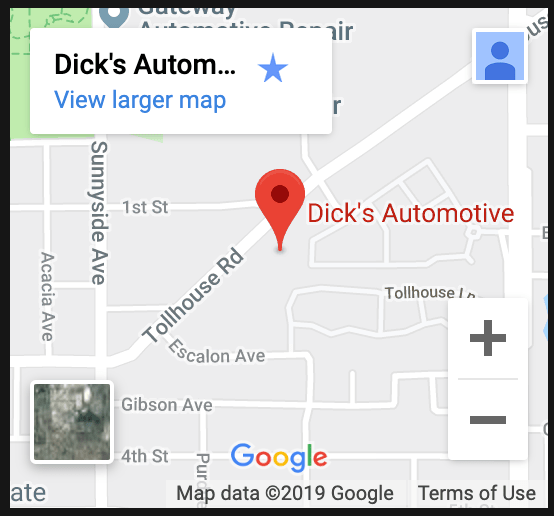Top 10 Unexpected Car Problems & How To Prevent Them

Photo by Grant Porter On Unsplash
Top 10 Unexpected Car Problems & How To Prevent Them
Unexpected car problems can throw a wrench into your plans and budget; hence, it is crucial to be aware of and prevent them as much as possible. At Dick’s Automotive, we have a deep passion for keeping your vehicles running smoothly and place a high value on empowering you with the knowledge that can save you time, money, and stress in the long run.
In this blog, we will shed light on some of the most common unexpected car problems and provide valuable insights on how to prevent them.
1. Overheating Engine
A car’s engine can overheat for various reasons, such as low coolant levels, a damaged radiator, or a malfunctioning thermostat. To prevent this, ensure regular coolant checks and flushes, maintain proper fluid levels, and never ignore warning signs like rising temperature gauges or steam escaping under the hood.
2. Dead Battery
Few things are as frustrating as a dead battery, especially in a hurry. Regularly inspect your battery for corrosion, check its voltage, and replace it as needed. Avoid leaving lights on or accessories plugged in when the engine is off.
3. Alternator Failure
The alternator is in charge of charging your battery and powering electrical systems. Signs of alternator trouble include dimming lights and warning lights on the dashboard. Regularly test your alternator’s output voltage and belt tension.
4. Transmission Issues
Your transmission is a key part of your vehicles functioning. Transmission problems can lead to costly repairs. Follow your manufacturer’s guidelines for transmission fluid changes and avoid aggressive driving habits that strain the transmission, such as letting your vehicle run hot, revving your engine, or accelerating wildly.
5. Brake System Troubles
Faulty brakes are a safety hazard! Regularly inspect brake pads, rotors, and fluid levels. This is one maintenance must you really can’t go without. If you hear grinding or experience pulsations when braking, don’t delay seeking professional help. Give us a visit at Dick’s Automotive in Clovis to get your brakes inspected if you’re worried!
6. Ignition System Problems
Faulty ignition components can leave you stranded. Ensure spark plugs, ignition coils, and wires are in good condition. Regular tune-ups can prevent unexpected ignition failures. This one can be expensive to fix, and makes using your vehicle nearly impossible. Keeping that maintenance scheduled regularly is going to be key here!
7. Leaking Fluids
Got a strange spot in your drive way? Leaking oil, coolant, or other fluids can indicate underlying issues. Regularly check your parking spot for drips and examine the engine bay for any signs of leaks.
8. Suspension & Steering Malfunctions
Worn-out shocks, struts, or steering components can cause a bumpy or shaky ride. These can be caused by off-roading, hitting curbs (we’ve all been there), or going to fast over speed bumps. Potholes also makes this a prevelant issue. Regularly inspect and replace these parts as recommended by your vehicle’s manufacturer, or give us a call at Dick’s Automotive to set up an appointment and make sure it’s all working as it should.
9. Air Conditioning Woes
A malfunctioning A/C system can make your drives uncomfortable. Run your A/C regularly, even in the cooler California months, to keep the system lubricated. If you notice reduced cooling, strange odors, or unusual noises, get it checked promptly. When it’s nice out, rolling the windows down is all good, but again, make sure you’re using your A/C every once in a while so mold doesn’t build up! Your A/C actually has an effect on your engine cooling, too, so it’s essential to have it in working conidtion!
10. Check Engine Light Mysteries
The dreaded check engine light can signal various issues, from minor to severe. Sometimes it means your gas cap has been left off, while it can sometimes mean your engine is on the fritz! It may be tempting as life goes on, but don’t ignore it! One way to take care of this at home and be prepared for it is to invest in a diagnostic scan to pinpoint the problem early, saving you from potential breakdowns and costly repairs. However, we’d suggest visiting a professional right away. You could also visit us at Dick’s Automotive in Clovis, CA for a Diagnostic Vehicle Inspection.
Conclusion
Proactive maintenance and regular inspections are the key to avoiding unexpected car problems. Understanding the top issues and their prevention strategies will make you better equipped to care for your vehicle and ensure its longevity. Our expert team is also here to support you on this journey, offering comprehensive maintenance services and reliable repairs when needed.
Come to the capable team of ASE-Certified mechanics and master mechanics at Dick’s Automotive in Clovis, CA, today. Please contact us today and please schedule an appointment via our website. Also, visit our Facebook page and get involved in our community!
Do You Have an Emissions Test Coming Up? Here’s What You Need to Know
Photo by Matt Boitor on Unsplash
Do You Have an Emissions Test Coming Up? Here’s What You Need to Know
If you’re a vehicle owner, you’re likely familiar with the concept of emissions testing. This crucial assessment ensures that vehicles meet the emissions standards set by regulatory bodies. At Dick’s Automotive in Clovis, California, we understand the importance of emissions testing and offer comprehensive testing services to help you stay compliant. In this blog, we’ll walk you through what emissions testing entails, why it’s necessary, how it’s done, and provide valuable tips to help you maintain a vehicle that passes the test every time.
What is an Emissions Test?
An emissions test is a procedure designed to measure the level of pollutants emitted by a vehicle’s exhaust system. It helps determine if a vehicle meets the emission standards set by environmental agencies and ensures that harmful pollutants, such as carbon monoxide and nitrogen oxide, are kept within acceptable limits. Regular emissions testing is vital for maintaining air quality and reducing the environmental impact of vehicles.
Why Do We Need Emissions Testing?
Emissions testing plays a crucial role in protecting the environment and public health. By ensuring vehicles comply with emission standards, we can reduce air pollution and minimize the adverse effects of vehicle emissions on our communities. Additionally, emissions testing helps identify potential issues with a vehicle’s engine or exhaust system, allowing for necessary repairs to be made promptly, thus improving overall vehicle performance and fuel efficiency.
How Is An Emissions Test Done?
During an emissions test, a certified technician will connect your vehicle to specialized equipment that measures its emissions. This typically involves attaching a probe to the exhaust system to collect samples while the engine runs at different speeds. The equipment analyzes the collected samples to determine the levels of pollutants the vehicle emits. The process is quick and straightforward, usually completed within 15 to 30 minutes.
Scheduling and Submitting Your Passing Test
To ensure compliance with local regulations, it’s essential to schedule your emissions test within the designated time frame. Check with your local authorities or the Department of Motor Vehicles (DMV) to determine the specific requirements and procedures for scheduling and submitting the test results. Some areas may have online systems or authorized testing centers where you can conveniently submit the test results. Be sure to record the test for future reference and potential vehicle sales.
Dick’s Automotive Emissions Testing Services
At Dick’s Automotive, we offer professional emissions testing services to help you fulfill your obligations and keep your vehicle running cleanly. Our certified technicians use state-of-the-art equipment to conduct accurate and reliable emissions tests. We understand the importance of prompt and hassle-free testing, and our friendly staff is here to guide you through the process, answer any questions, and ensure your seamless experience.
Tips to Keep Your Car in Shape for Emissions Testing
Regular Maintenance: Adhere to your vehicle’s recommended maintenance schedule, including routine oil changes, filter replacements, and spark plug checks. Regular maintenance helps keep your engine running efficiently and reduces the likelihood of emissions-related issues.
Drive Smart: Practice smooth driving habits, avoid excessive idling, and minimize rapid acceleration and braking. These habits promote better fuel efficiency and help reduce emissions.
Check the Check Engine Light: If your check engine light is on, promptly address the underlying issue. Ignoring it can lead to failed emissions tests. Bring your vehicle to Dick’s Automotive for comprehensive diagnostic and necessary repairs.
Use High-Quality Fuel: Opt for high-quality fuel from reputable gas stations. Quality fuel helps maintain engine performance and reduces the risk of fuel-related issues that could affect emissions.
Maintain Exhaust System: Regularly inspect your vehicle’s exhaust system for leaks, damage, or corrosion. A well-maintained exhaust system ensures proper emission control.
What to Do If Your Car Doesn’t Pass the Test
If your vehicle doesn’t pass the emissions test, don’t panic. It’s essential to address the underlying issue promptly. Bring your vehicle to Dick’s Automotive for a thorough inspection and necessary repairs. Our experienced technicians will diagnose the problem and provide the necessary solutions to help your vehicle meet the required emissions standards.
Dick’s Automotive Is Here For All Your Vehicle Needs
Emissions testing is a vital aspect of responsible vehicle ownership, ensuring that our cars operate in an environmentally friendly manner. At Dick’s Automotive in Clovis, we offer comprehensive emissions testing services to help you meet regulatory requirements. By following the provided tips and correctly maintaining your vehicle, you can easily increase the likelihood of passing the emissions test.
Don’t hesitate to visit the capable team of ASE-Certified mechanics and master mechanics at Dick’s Automotive in Clovis, CA, today. Please contact us today and please schedule an appointment via our website. Also, visit us on our Facebook page and get involved in our community!
Back To School Tips For New Drivers
As summer draws to a close and the school year approaches, it’s an exciting time for new drivers who will be hitting the road to get to their classes. Whether you’re a high school student or a college freshman, it’s important to prioritize safety and be prepared for the challenges of driving in a school environment. To help you navigate this transition smoothly, here are some valuable back-to-school tips for new drivers:
1. Familiarize Yourself with School Zones and Speed Limits
School zones have reduced speed limits during certain hours to ensure the safety of students. Take the time to familiarize yourself with the locations of school zones in your area and the specific speed limits that apply. Slow down and adhere to these speed limits, especially during arrival and dismissal times, to avoid any potential accidents and ensure the safety of pedestrians.
2. Leave Early and Plan Your Route
Give yourself ample time to reach your destination. Leaving early allows you to avoid rushing and reduces the temptation to speed or engage in risky behaviors. Plan your route ahead of time, considering any potential congestion or road closures due to school activities. Use navigation apps or GPS devices to stay informed about traffic conditions and find alternative routes.
3. Minimize Distractions
Distracted driving is a significant safety concern for drivers of all ages. Keep your focus on the road by minimizing distractions inside your vehicle. Avoid using your phone, eating, or engaging in other activities that distract your attention from driving. If you need to use your phone, pull over to a safe location before doing so. Remember, the safety of yourself, your passengers, and others on the road should always be your top priority.
4. Watch Out for School Buses and Pedestrians
School buses are a common sight during the school year. Be mindful of their frequent stops and the flashing lights indicating that students are getting on or off the bus. Passing a school bus with its stop sign extended is illegal. Exercise caution and be prepared to stop when you see a school bus.
Additionally, be vigilant for pedestrians, especially children, who may be crossing the road or walking near schools. Be patient and yield to pedestrians at crosswalks, and always be aware of your surroundings.
5. Observe Parking Regulations
When parking near schools or on campus, adhere to all parking regulations. Illegally parked vehicles can cause congestion and inconvenience for other drivers. Follow designated parking areas, display any required permits, and respect the rights of other drivers and pedestrians.
6. Maintain Your Vehicle
Regular vehicle maintenance is crucial for safe and efficient driving. Ensure that your tires are properly inflated, lights are functional, and brakes are in good condition. Schedule regular oil changes and inspections to keep your vehicle running smoothly. Taking care of your vehicle reduces the risk of unexpected breakdowns and helps ensure your safety on the road.
7. Practice Defensive Driving
Practicing defensive driving techniques can significantly reduce the chances of accidents. Be aware of other drivers’ behaviors and anticipate their actions. Keep a safe following distance, signal your intentions, and be prepared to react to sudden changes in traffic. Stay calm and avoid aggressive maneuvers that can escalate situations.
Conclusion
As a new driver heading back to school, it’s essential to prioritize safety, be mindful of school zones, minimize distractions, and watch out for buses and pedestrians. By following these tips and being cautious, you can start the school year confidently and enjoy a safe driving experience. Remember, responsible driving protects yourself and contributes to the well-being of your fellow students and community. Good luck with your studies, and have a great academic year!
Don’t hesitate to visit the capable team of ASE-Certified mechanics and master mechanics at Dick’s Automotive in Clovis, CA, today. Please contact us today and please schedule an appointment via our website. Also, visit us on our Facebook page and get involved in our community!
How To Properly Maintain Your Vehicle As A New Driver
As a new driver, it is important to not only learn how to operate your vehicle safely but also to properly maintain it to ensure its longevity and safety on the road. In this article, we will discuss the essential maintenance tasks that every new driver should know.
Regular Maintenance Tasks
Regular maintenance tasks are essential to keep your vehicle running smoothly and safely. Here are some of the essential tasks that you should perform regularly:
Check the Oil
Checking the oil level and quality is essential to keep your engine running smoothly. Your vehicle owner’s manual will specify how often to check the oil and what type of oil to use. Make sure to check the oil level regularly and change it according to the manufacturer’s recommendations.
Check the Tires
Regularly checking the tire pressure and tread depth is essential to maintain good traction and prevent accidents. Your vehicle owner’s manual will specify the recommended tire pressure and tread depth. Make sure to check the tires regularly and replace them if the tread depth is below the recommended level.
Check the Brakes
The brakes are an essential safety feature of your vehicle. Make sure to have them checked regularly by a professional mechanic. Signs of brake problems include squeaking or grinding noises, a soft or spongy brake pedal, or the vehicle pulling to one side when braking.
Check the Battery
Your vehicle’s battery provides power to the engine and electrical components. Make sure to check the battery regularly and replace it if it is old or weak. Signs of a weak battery include slow cranking when starting the engine or dimming headlights.
Preventative Maintenance Tasks
Preventative maintenance tasks are essential to prevent major problems and extend the life of your vehicle. Here are some of the essential preventative maintenance tasks that you should perform regularly:
Change the Air Filter
The air filter prevents dirt and debris from entering the engine. Make sure to replace the air filter according to the manufacturer’s recommendations.
Flush the Cooling System
The cooling system prevents the engine from overheating. Over time, the coolant can become contaminated or lose its effectiveness. Make sure to flush the cooling system according to the manufacturer’s recommendations.
Replace the Timing Belt
The timing belt keeps the engine’s moving parts in sync. If the timing belt fails, it can cause serious engine damage. Make sure to replace the timing belt according to the manufacturer’s recommendations.
Replace the Spark Plugs
The spark plugs ignite the fuel in the engine. Over time, they can become worn or dirty, leading to poor performance or reduced fuel efficiency. Make sure to replace the spark plugs according to the manufacturer’s recommendations.
Conclusion
Properly maintaining your vehicle is essential to ensure its longevity and safety on the road. As a new driver, it is important to learn the regular and preventative maintenance tasks that your vehicle requires. By following the manufacturer’s recommendations and having your vehicle serviced regularly by a professional mechanic, you can keep your vehicle running smoothly and safely for years to come.
Come to the capable team of ASE-Certified mechanics and master mechanics at Dick’s Automotive in Clovis, CA, today. Please contact us today and please schedule an appointment via our website. Also, visit us on our Facebook page and get involved in our community!
5 Common Reasons For A Malfunctioning Car A/C System
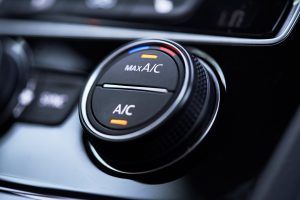
5 Common Reasons for a Malfunctioning Car A/C System
As the summer months approach and temperatures rise, a properly functioning car air conditioning (A/C) system is essential. However, A/C systems can sometimes malfunction, causing discomfort and inconvenience for drivers.
A functioning car A/C system is essential for a comfortable driving experience, especially in hot and humid conditions. However, A/C systems can sometimes malfunction, causing discomfort and inconvenience for drivers.
In this article, we will discuss the common reasons for a malfunctioning car A/C system and how it is affected by the weather and agriculture in Fresno County, California.
Importance of A/C System in a Car
A car A/C system serves the purpose of regulating the temperature inside the car, providing a comfortable environment for the driver and passengers. Apart from providing comfort, a car A/C system is also important for safety reasons. A hot and stuffy environment inside the car can lead to drowsiness and fatigue, which can be dangerous for the driver and other passengers.
Common Reasons for A/C System Malfunctioning
There are several reasons why a car’s A/C system can malfunction. Here are the most common reasons:
Low Refrigerant Levels
The refrigerant is a vital component of the A/C system that absorbs heat from the air inside the car and releases it outside. If the refrigerant levels are low, the A/C system will not function properly. Low refrigerant levels can be caused by leaks in the system or simply due to evaporation over time.
Leaking Refrigerant
Refrigerant leaks are a common issue with car A/C systems. Leaks can occur due to damaged or worn-out components, such as the hoses or the compressor. A leak in the A/C system can cause a decrease in refrigerant levels, which will result in poor A/C performance.
Faulty Compressor
The compressor is responsible for compressing the refrigerant and circulating it through the A/C system. If the compressor is faulty, the refrigerant will not be able to circulate properly, leading to poor A/C performance or a complete malfunction.
Electrical Issues
The A/C system is dependent on various electrical components, such as fuses, relays, and switches. If any of these components fail, the A/C system will not function properly. Electrical issues can also lead to short circuits, which can damage other components of the A/C system.
Clogged Condenser
The condenser is responsible for releasing the heat absorbed by the refrigerant. If the condenser becomes clogged, it will not be able to release the heat properly, leading to poor A/C performance. A clogged condenser can be caused by debris or dirt accumulation.
Fresno County and A/C System
Fresno County, California, is known for its hot weather and agriculture, which can have an impact on car A/C systems. Hot weather can put a strain on the A/C system, causing it to work harder than usual, leading to a higher risk of malfunction.
Agriculture can also be a factor, as the dust and debris from fields can clog the condenser and air filter, reducing the efficiency of the A/C system. It is important to keep the A/C system clean and maintained to ensure optimal performance.
How to Avoid A/C System Malfunctioning
Regular maintenance of the car A/C system can help avoid malfunctions and ensure optimal performance. Here are some tips to keep the A/C system in good condition:
- Get the A/C system inspected and serviced regularly by a qualified mechanic.
- Check the refrigerant levels and top-up if necessary.
- Keep the condenser and air filter clean and free of debris.
- Use the A/C system regularly to keep the components lubricated and prevent leaks.
- Park the car in a shaded area to reduce the strain on the A/C system.
By following these tips, you can avoid A/C system malfunctions and ensure a comfortable driving experience, even in hot and humid conditions.
Conclusion
A malfunctioning car A/C system can cause discomfort and inconvenience, especially during hot and humid weather. The common reasons for A/C system malfunctions include low refrigerant levels, leaking refrigerant, faulty compressors, electrical issues, and clogged condensers. Regular maintenance and inspection of the A/C system can help avoid malfunctions and ensure optimal performance.
Come to the capable team of ASE-Certified mechanics and master mechanics at Dick’s Automotive in Clovis, CA, today. Please contact us today and please schedule an appointment via our website. Also, visit us on our Facebook page and get involved in our community!
What Is A Catalytic Converter & How Can I Protect Mine?
Protect Your Catalytic Converter from Theft in California
As an auto repair shop serving the greater Fresno, Ca area, we know how important it is to protect your car. One of the most expensive parts of a car to replace is the catalytic converter, which is why it has become a target for thieves here in California. In this blog post, we’ll discuss what a catalytic converter is and how you can protect yours from theft.
What Is A Catalytic Converter?
A catalytic converter is an exhaust component that reduces your vehicle’s harmful emissions while running. It works as a filter to reduce pollutants like carbon monoxide and nitrogen oxide that can damage air quality and human health. The catalytic converter also helps your engine run more efficiently, making it easier for your car to pass emissions tests.
Why Is Catalytic Converter Theft on the Rise in California?
Catalytic converters are made with precious metals like palladium, platinum, and rhodium—all incredibly valuable materials on the open market.
Thieves have been targeting cars in California because they know they can sell these materials for a high price without doing much work. To make matters worse, replacing a catalytic converter is not cheap; depending on the make and model of the car, it could cost anywhere from $1,000-$3,000 or more!
How Can I Protect My Catalytic Converter From Theft?
Fortunately, there are some steps you can take to help protect your catalytic converter from theft:
- Park your car in well-lit areas when possible; thieves tend to avoid brightly lit places at night.
- If possible, put up security cameras around where you park; this will deter potential thieves since they don’t want their faces caught on camera.
- Install anti-theft devices like wheel locks or steering wheel locks; these make it harder for thieves to remove the part quickly and easily, so they’ll likely move on if they see one in place.
- Have your vehicle regularly serviced at our Clovis auto repair shop; we can inspect the catalytic converter and check its condition so you can catch any problems before they become serious issues.
Protecting Your Catalytic Converter From Theft
At our Clovis auto repair shop, we want our customers to stay safe out on the roads of Fresno County and beyond –that’s why we hope these tips will help keep your car safe from catalytic converter theft!
Remember that parking in well-lit areas, putting up security cameras if possible, installing anti-theft devices like wheel locks or steering wheel locks, and having regular services done at our shop all go a long way towards protecting yourself from potentially expensive repairs down the line! If you have any questions about catalytic converters or other car services, please feel free to reach out! We’d love to hear from you!
Come to the capable team of ASE-Certified mechanics and master mechanics at Dick’s Automotive in Clovis, CA, today. Please contact us today and please schedule an appointment via our website. Also, visit us on our Facebook page and get involved in our community!
The 5 Vehicle Fluids You Need To Know (& 1 Bonus Fluid You Might Not Have Thought About)
Understanding Vehicle Fluids: The Basics
As an auto repair customer, it’s essential to understand the various fluids your vehicle requires, especially in the extreme weather conditions sometimes present in the California Central Valley. Sever heat, surprise rain showers, and dusty agricultural roads all create problems for your vehicle’s fluids.
Without its fluids, your car or truck would not be able to function correctly. Today we will look at the five most common vehicle fluids and one bonus fluid you may have yet to consider.
The 5 Essential Vehicle Fluids
Oil
Oil lubricates the engine and helps keep it cool. It needs to be changed every 3,000-7,000 miles depending on the type of oil used and how you drive. Furthermore, changing the filter is essential and protects your vehicle over time.
Transmission Fluid
Transmission fluid helps with shifting gears, allowing your vehicle to safely transition from first, to second, to third, and so on. If your vehicle has difficulty shifting gears, you may need a transmission fluid flush or refill. Dick’s Automotive is here to help you with both!
Brake Fluid
Brake fluid helps power the brakes to stop your vehicle when needed. Ensure you check your brake fluid regularly, as this can decrease over time and must be refilled before brakes become inoperable or unsafe.
Coolant
Coolant is responsible for keeping your engine cool, so it doesn’t overheat, a critical element in Clovis, CA’s extreme heart. A coolant leak could cause significant damage to your engine if left unattended for too long, so check on this regularly as well.
Power Steering Fluid
Power steering fluid helps make turning much easier in cars and trucks by providing hydraulic pressure to assist in turning the wheel. This should also be checked as you may need to “top it up” occasionally for optimal performance from your vehicle’s power steering system.
Bonus Fluid: Windshield Washer Fluid
Windshield washer fluid is usually filled into a separate reservoir near where you fill up with windshield wiper blades for your car or truck’s windshield wipers system and helps clear away dirt, mud, and debris from the windshield when activated with a switch inside of the cabin of the vehicle. Keeping windshield washer fluid topped off will ensure you always have clean visibility out of the front window while driving!
Let Dick’s Automotive in Clovis, CA, Help You With Your Vehicle’s Fluids
Knowing how to identify each of these fluids is important if you own a car or truck because it allows you to spot any problems early before they become more serious issues down the line or cause any dangerous situations while driving due to a lack of proper maintenance on any one of these fluids!
Make sure that all these essential fluids are always checked regularly and kept topped up where necessary so that your car runs smoothly and safely! Dick’s Automotive help ensure all of these fluids are appropriately maintained during servicing appointments!
Visit the incredible team of ASE-Certified mechanics and master mechanics at Dick’s Automotive in Clovis, CA, today. Please contact us today and please schedule an appointment via our website. Also, visit us on our Facebook page and get involved in our community!
Why Tire Tread Depth Is Important For Safe Driving
The Benefits of Proper Tire Tread Depth
As a car owner, you know that your tires play a crucial role in your vehicle’s performance. But did you know that the tread depth of your tires can significantly affect your safety while driving? In this blog, we’ll explore the role of tire tread depth in handling and performance and provide tips on properly caring for your tires to ensure optimal safety on the road, all from the perspective of automotive professionals. So let’s get started!
What Is Tire Tread Depth?
Tire tread depth is the depth of grooves, or “tread,” that are visible in your tire’s rubber surface. The peaks and valleys between the higher and lower parts of the rubber; that’s what we mean when we say tread!
These grooves help disperse water and provide traction between the tire and the road, which improves handling and braking performance in wet weather conditions. The deeper the groove, the more effectively it can disperse water and provide traction. This is why maintaining proper tire tread depth is so important for safe driving.
Why Is Tire Tread Depth Important For Safety?
Adequate tire tread depth helps keep your vehicle stable on wet roads, especially when turning or braking suddenly, by providing better traction between the road surface and the tires. If your tires have low tread, they may not be able to grip the road as effectively, leading to reduced control over steering and braking.
Low tire tread increases the risk of hydroplaning or skidding off-road in wet weather conditions. Moreover, low tire tread can lead to poor fuel economy because your engine has to work harder to move a car with low tread than one with sufficient tread depth.
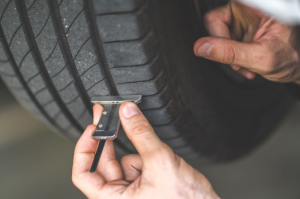
How To Identify Low Tire Tread Depth?
You can identify low tire tread by using a penny test or a specialized tool called a “tire gauge.” To perform a penny test, insert a penny into several points across each tire’s groove with Lincoln’s head facing down towards the groove; if you can see all of Lincoln’s head, then it’s time for new tires!
If you don’t have access to a penny, using a “tire gauge” will also help you measure tire pressure accurately as well as identify if any of your tires are wearing down too much due to improper inflation levels or frequent use over long distances at higher speeds on highways/motorways etc. The recommended minimum is 2/32 inch (1 mm) of remaining tread depth across all four tires – you should replace anything less than this as soon as possible for optimal road safety.
How Do You Care For Your Tires’ Tread?
Properly inflated tires are essential for ensuring optimal performance and longevity. Each tire has it’s own pressure limits, and you can usually find that inside the side of your driver’s door, on a sticker. Additionally, ensure that all four tires are rotated regularly (every three months or after 1-2,000 miles), so they wear evenly.
This will help maintain their overall performance/life span over time without having any side effects such as premature wear & tear due to excessive loading/movement on one side only etc. An alignment check every six months will help reduce uneven tire wear due to misalignment problems caused by rogue potholes etc.
Why You Want A Professional To Help You Care For Your Tires
It is important to have a professional help you care for your tires because they have the training and expertise to properly inspect and care for your tires, the tools and equipment to do the job efficiently and accurately, and can ensure that your tires are in good condition for safety on the road.
Additionally, a professional can save you time and effort by taking care of the tire care process for you. Overall, seeking the help of a professional to care for your tires can provide peace of mind, ensuring that your tires are ready to handle the demands of the road.
Establishing regular service intervals with a trusted auto repair center will help ensure your tires stay healthy and safer for longer. Tread depth is important for a myriad of reasons, and you don’t want to overlook the safety basics when on the road.
Visit the incredible team of ASE-Certified mechanics and master mechanics at Dick’s Automotive in Clovis, CA, today. Please contact us today and please schedule an appointment via our website. Also, visit us on our Facebook page and get involved in our community!
6 Common Reasons Your Check Engine Light Comes On
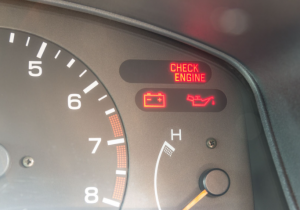
What Causes Your Check Engine Light to Come On?
The check engine light is one of the most common indicators of something wrong with your car. But what does it mean when it comes on? Let’s take a look at six of the most common ones, so you can know what to look and listen for in the future.
Loose or Faulty Gas Cap
A loose or faulty gas cap is one of the easiest causes of a check engine light coming on. The gas cap is designed to seal up your fuel tank and keep the pressure inside, which helps prevent fuel from evaporating and keeps your car running more efficiently. If you notice that your gas cap isn’t screwed in all the way, or if you detect any cracks or other signs of damage, you should replace it as soon as possible.
Incorrectly Installed Air Filter
The air filter in your car helps prevent dirt and debris from getting into your engine, but if it’s not installed correctly, then it won’t be able to do its job properly. If you recently replaced an air filter, make sure it was put back in correctly; otherwise, your check engine light may come on due to poor airflow.
Faulty Oxygen Sensor
Your oxygen sensor measures how much oxygen is present in the exhaust fumes produced by your car’s engine. If this sensor goes bad, then it can cause a whole host of problems, including reduced fuel efficiency and increased emissions – which could trigger the check engine light to come on. In this instance, you’ll need to have your oxygen sensor replaced as soon as possible.
Old & Faulty Spark Plugs
Spark plugs help ignite the fuel in your car’s combustion chamber, while spark plug wires help carry electricity from the ignition system to those spark plugs. Over time, these parts can wear down and cause misfires, leading to a check engine light coming on. Have these parts inspected regularly by a qualified mechanic so any worn-out parts can be replaced before they cause major issues with your vehicle.
Failing Catalytic Converter
Your catalytic converter helps reduce harmful emissions produced by your car’s exhaust system by converting them into less toxic substances before they’re released into the atmosphere. If this part fails, it can cause excessive emissions, which can trigger the check engine light to come on, so you’ll need to have it replaced as soon as possible if that caused the issue in the first place.
Bad Mass Air Flow Sensor
The mass airflow sensor measures how much air enters your vehicle’s engine and sends that information back to the computer so it can adjust accordingly for optimal performance. If this sensor fails, then it could lead to decreased performance and increased emissions—both of which could trigger a check engine light warning signal.
No one likes seeing their check engine light come on, but luckily there are usually simple solutions to fix whatever caused it in the first place! Whether you need a new gas cap, spark plug wires, or a catalytic converter replacement – be sure to take action immediately so any potential problems don’t worsen over time! For auto repair customers dealing with this issue, don’t hesitate to reach out for help when needed!
A certified professional will know exactly what needs doing for a quick resolution without compromising safety or reliability!
Visit the incredible team of ASE-Certified mechanics and master mechanics at Dick’s Automotive in Clovis, CA, today. Please contact us today and please schedule an appointment via our website. Also, visit us on our Facebook page and get involved in our community!
5 Essential Vehicle Maintenance Tips From The Pros
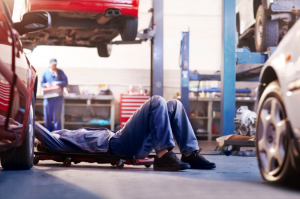
Auto Maintenance Tips You Need To Know
Winter is the perfect time to take your vehicle in for some much-needed TLC. We asked our auto repair pros to weigh in on their essential maintenance tips to keep your car running all season long. Here are their top five recommendations!
1. Check Your Tire Pressure
This one is quick and easy to do yourself, and it can make a big difference in how your car handles on the road. Be sure to check your owner’s manual for the correct tire pressure for your vehicle. You can find this information on a sticker inside the driver’s side door or on the glove box door.
2. Get an Oil Change
It’s important to change your oil every 3,000-5,000 miles or according to your manufacturer’s recommendations, whichever comes first. This will help keep your engine running smoothly and prevent a build-up of sludge and other contaminants.
3. Inspect Your Brakes
If you notice any strange noises or vibrations when you brake, it’s time to have them checked out by a professional. It’s also a good idea to have your brakes inspected at least once a year to ensure they are in good working condition.
4. Flush Your Cooling System
Over time, rust and other contaminants can build up in your cooling system, which can lead to engine problems. Flushing your system and changing your antifreeze will help keep your engine running cool, even on the hottest summer days.
5. Check Your Battery
Cold weather can be tough on batteries, so it’s a good idea to have yours checked before summer begins. If it’s been over three years since you’ve replaced your battery, now is a good time to do so.
These are just a few essential maintenance tips to keep in mind this summer. For more detailed information about your vehicle, consult your owner’s manual or bring it in for service at Dick’s Automotive. Our experienced technicians would be happy to answer any questions you may have about car care!Meet the incredible team of ASE-Certified mechanics and master mechanics at Dick’s Automotive in Clovis, CA, today. Please contact us today and please schedule an appointment via our website. Also, visit us on our Facebook page and get involved in our community!
